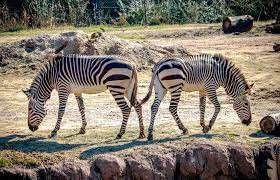Spot Hartmanns Mountain Zebra – Hartmann’s mountain zebra (Equus zebra hartmannae) is a subspecies of the mountain zebra found in far south-western Angola and western Namibia, easily distinguished from other similar zebra species by its dewlap as well as the lack of stripes on its belly. Their range is limited to a few mountainous regions in southwestern Angola and the coastal mountain ranges of Namibia. Like many members of the horse family, Hartmann’s mountain zebras mostly rely on body language to communicate.
 Hartmann’s mountain zebras Equus zebra hartmannae occur in the mountainous transition zone between the Namib Desert and the central plateau in Namibia. The Cape mountain zebra differs slightly from the Hartmann’s subspecies, being stockier and having longer ears and a larger dewlap. Adults have a shoulder height of 116 to 128 cm, making them the most lightly built subspecies of zebra.
Serengeti National Park, Tanzania. Over a million wildebeest and more than 200,000 zebras head south from Kenya to Tanzania every October and November; returning northwards after the long rains from April to June. Kulans are the zebras of Asia. They used to roam on a massive territory stretching from Syria to Mongolia but today their populations are fragmented and vulnerable. Kulans in Central Asia are in particular danger.
Nearing a population size of 13,000, the Hartmann’s Zebra roams along mountain escarpments, slopes, and plateaus 2,000 meters above sea level during the hot summer months and migrates to lower savannah landscapes during winter. Conversion of much of the mountain zebra’s habitat for agricultural production contributes heavily to the animal’s endangered status.
Native to Africa, zebras are distinctive single-hoofed mammals that live in herds. According to the IUCN Red List, the total population of Mountain zebras is estimated at around 9,000 mature individuals. The current total population size of the Cape mountain zebra subspecies is 1,500 individuals (500 mature individuals).
The Grévy’s zebra is considered endangered. Its population was estimated to be 15,000 in the 1970s and by the early 21st century the population was lower than 3,500, a 75% decline. Lions, hyenas, wild dogs, cheetahs and leopards prey on zebras, but man is the most deadly of all predators. Zebras outside reserves are killed for their decorative hides and fly whisk tails. To evade a predator the Hartmann’s mountain zebra can gallop up to 40 miles per hour and jump a 6-foot wall.
Hartmann’s mountain zebras Equus zebra hartmannae occur in the mountainous transition zone between the Namib Desert and the central plateau in Namibia. The Cape mountain zebra differs slightly from the Hartmann’s subspecies, being stockier and having longer ears and a larger dewlap. Adults have a shoulder height of 116 to 128 cm, making them the most lightly built subspecies of zebra.
Serengeti National Park, Tanzania. Over a million wildebeest and more than 200,000 zebras head south from Kenya to Tanzania every October and November; returning northwards after the long rains from April to June. Kulans are the zebras of Asia. They used to roam on a massive territory stretching from Syria to Mongolia but today their populations are fragmented and vulnerable. Kulans in Central Asia are in particular danger.
Nearing a population size of 13,000, the Hartmann’s Zebra roams along mountain escarpments, slopes, and plateaus 2,000 meters above sea level during the hot summer months and migrates to lower savannah landscapes during winter. Conversion of much of the mountain zebra’s habitat for agricultural production contributes heavily to the animal’s endangered status.
Native to Africa, zebras are distinctive single-hoofed mammals that live in herds. According to the IUCN Red List, the total population of Mountain zebras is estimated at around 9,000 mature individuals. The current total population size of the Cape mountain zebra subspecies is 1,500 individuals (500 mature individuals).
The Grévy’s zebra is considered endangered. Its population was estimated to be 15,000 in the 1970s and by the early 21st century the population was lower than 3,500, a 75% decline. Lions, hyenas, wild dogs, cheetahs and leopards prey on zebras, but man is the most deadly of all predators. Zebras outside reserves are killed for their decorative hides and fly whisk tails. To evade a predator the Hartmann’s mountain zebra can gallop up to 40 miles per hour and jump a 6-foot wall.
